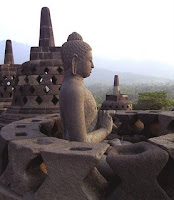
The great ancient relic in South Asia was built with 60, 000 meter cubic of stones make this temple as the place where almost everybody want to admire it.
It was supposed to be dated in 8th century with its name probably derived from Sankrit word “ Vihara Buddha Uhr” which means Buddhist monastery located on the hill.
This temple besides as the symbol of Buddhism, the stupa of Borobudur is also a replica of the world (universe) which is divided into three levels, the lowest, middle, and the highest.
It describes also the journey of Siddhartha from the time he was born, reincarnated and being a Buddha. Cleary carved on its wall. To follow this story, we should walk with clock wise direction, from one floor to another where finally you should climb up to the top of it where you can find the biggest stupa.
When we reach the highest level, it symbolizes the perfectness where there is no other needs except with God.
Beyond all of those beliefs, the location of the temple is among the Menoreh hill, Sindoro and Sumbing volcanoes also Merbabu Merapi volcanoes.
It is on the other hand, a good place to enjoy the landscape or enjoying the sunrise from its top.
The other few kilometers temples are Mendut and pawon temple.
Though the two temples are not as big as Borobudur temple, but Mendut temple houses an outstanding 3 meters height statue.


The most popular and well known of East Java's tourist attractions is undoubtedly Mt Bromo. The pre-dawn departure and trek across the mountain's famous 'sand sea', to watch the sunrise at the crater rim, has become something of a ritual, enacted daily by people of every nationality. Bromo is actually just one crater in the vast, 800 km2 Tengger massif, which forms the largest of East Java's five main volcanic ranges. Although by no means the highest mountain in the region (2392m), it has gained its reputation partly because of its unique location and partly through the reverence shown to it by the local inhabitants.
A legend connected with Mt Bromo tells of the origin of the Tenggerese people. According to the story, it was during the closing years of the 15th century, when the East Javanese empire of Majapahit was in decline, that a princess of the kingdom, named Roro Anteng, and her husband Joko Seger, retreated to the Bromo region and established a separate principality, which they named Tengger, a combination of the last syllables of each of their names.
The region, it is said, de veloped and prospered, yet no descendants were born to the ruling couple.
Bromo - Tengger located at Semeru National Park. Its covers some 800 square kilometres in the centre of East Java. It is the largest volcanic region in the province and contains the island’s highest mountain, Semeru, which rises 3,676 metres above sea - level. The ten kilometre wide ’sand sea’ of Bromo has become East Java’s most famous attraction.
The Park is home to quite a number of rare and protected plants, among them the dwarf shrub styphelia javanica (L.) with its fragrant white flowers, as well as a special type of rhododendron. Higher mountain regions are covered in hardy cemara (casuarina) trees, while the lower slopes are used partially for commercial forest plantations. The range of fauna here has not been fully recorded, though a few species, such as the wild pig, Timorese deer and muncak (barking deer) exist in considerable numbers. There are also leopards, flying squirrels and a variety of duck and other waterfowl.
The Bromo/Semeru region is inhabited by the Tenggerese, who to this day retain a Hindu/Javanese faith. Isolated for centuries, they have remained loyal to the old ways and practice a religion which is almost identical to that found on neighbouring Bali. A centre for traditional Tenggerese culture is at Wonokitri, where a large Hindu temple has been built quite recently.
The Bromo/Semeru region is inhabited by the Tenggerese, who to this day retain a Hindu/Javanese faith. Isolated for centuries, they have remained loyal to the old ways and practice a religion which is almost identical to that found on neighbouring Bali. A centre for traditional Tenggerese culture is at Wonokitri, where a large Hindu temple has been built quite recently.
Bromo isn’t the highest mountain in Java — that honor goes to nearby Mount Semeru at 3,676m — but it’s probably the most famous one. Bromo is in fact only one of many peaks inside the massive Tengger Caldera, but it’s easily recognized as the entire top has been blown off and the crater inside constantly belches white sulphurous smoke. The inside of the caldera, aptly dubbed the Laut Pasir (Sea of Sand) is coated with fine volcanic sand and the overall effect is unsettlingly unearthly, especially when compared to the lush green valleys all around the caldera.
The major access point is Cemoro Lawang at the northeast edge, but there are also trails from Tosari (northwest) and Ngadas (west). The village of Ngadisari, on the road from Probolinggo about 5.5 km before Cemoro Lawang, marks the entrance to the national park. Both Cemoro Lawang and Ngadisari are rather picturesque, with brightly-painted houses and flower beds outside.

Sewu temple complex located in Prambanan Temple area, around 800 meters towards Rara Jongrang Temples. Sewu temple is the second biggest Budha temple in Central Java after Candi Borobudur. The fact that this temple similar in area Prambanan temple is evidence that at that moment Hindu believer and Budha lives in compatibility and harmonious.
It is said, to be an empire temple is one of main activity in the past. Based on inscription built in the year 792 SAMARIUMS found in the year 1960, name of the temple complex is estimated " Manjus'rigrha" ( House Manjusri). Manjusri is one of Boddhisatva in teaching Budha. Sewu temple possibility built at 8 century the end of goverment Rakai Panangkaran. Rakai Panangkaran ( 746 SAMARIUMS – 784 SAMARIUMS) be one of popular king at empire of ancient Mataram. This temple first time checked by HC Cornellius in the 1807.
Main temple has one main spaces and four small rooms that incircuit with temple. Door of functioning east as main gate towards main space. Main temple looks towards east. Temple structure has 9 roof, where each roof forms a stupa at its height.

Prambanan temple is beautiful extraordinary building built in 10 century during goverment two kings (Rakai Pikatan and Rakai Balitung). This temple is located 17 kilometre from downtown Yogyakarta, in the middle of area that is now is built garden to respect.
Prambanan temple has 3 main temple in main yard, that is Wisnu, Brahma, and Siwa temple. Third temple is symbol Trimurti in Hindu trust. Third the temple faces easterly. Every main temple has one associate temples facing to west, that is Nandini for Siwa, Angsa for Brahma, and Garuda for Wisnu. Besides, still there is 2 temple flanks, 4 temple kelir, and 4 corner temple. Temporary, having second yard 224 temples.
Prambanan also has relief loading story Ramayana. According to the experts, the relief looks like story Ramayana which is derivable passed oral tradition. Interesting other relief is tree Kalpataru which in Hinduism is considered to be tree life, continuity and area compatibility. In Prambanan, tree relief Kalpataru depicted to be middle flanks lion. Existence of this tree makes the experts to assume that 9 century public has wisdom in managing its environment.

In addition to being the most popular beach in Yogyakarta, Parangtritis is worth visiting since it is closely related to such tourism objects as the Sultan Palace in Yogyakarta city, Parangkusumo Beach to the west of it, and the Merapi area at the north part of Yogyakarta.
Parang ritis beach is located 50 kilometters from the centre of jogja. Parang tritis is a very beautiful beach with the a big wave. Here you may not surf the wave because the wave is very danger. Here you can play with the sands you can also take a sport here. The wind is very strong then you can enjoy the sea. You can watch as far as you can. You will never find the ships here. You can also do fishing here.
To get to Parangtritis Beach, you can take either one of the two routes. One is the route of Yogyakarta-Imogiri-Siluk-Parangtritis with the river and coral reel scenery on the way. The other is Yogyakarta-Parangtritis route that is easier to take with quite smooth road. It is suggested that you do not wear green clothes to respect local people who believe that green clothes will bring misfortune.
Parangtritis Beach is a lovely beach with many impressing phenomena, naturally and supra naturally. The waves regularly bring in new wood and bamboo, washing ashore from another nearby beach probably. Some wood is picked and taken away by locals to be used for their own house. Parangtritis is an enchanting sloping beach combined with rocky hills, dunes, and a white sandy beach. Besides being famous as a recreational spot. Parangtritis is also a sacred place. Many people come to the beach to do meditation. Up to now, this area is remaining functioned as the place to perform the traditional ceremony called labuhan. Many hotels and restaurants are available for sunbathe lovers.







